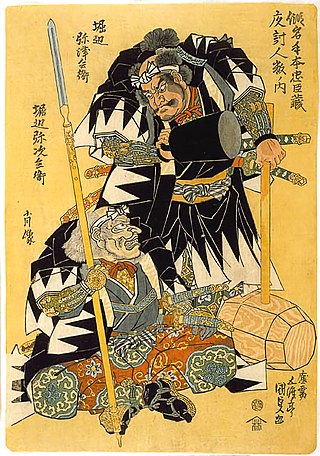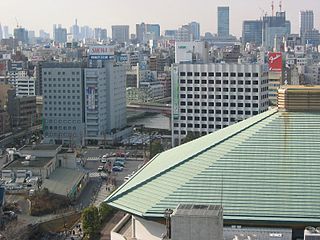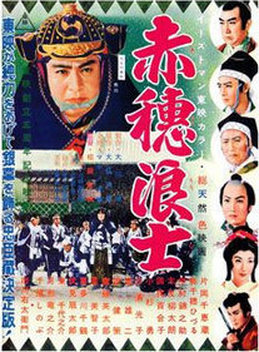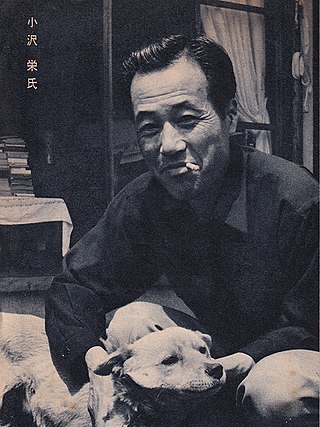Contents
| |||||
| Decades: | |||||
|---|---|---|---|---|---|
| See also: | Other events of 1703 History of Japan • Timeline • Years | ||||
Events in the year 1703 in Japan .
| |||||
| Decades: | |||||
|---|---|---|---|---|---|
| See also: | Other events of 1703 History of Japan • Timeline • Years | ||||
Events in the year 1703 in Japan .

1703 (MDCCIII) was a common year starting on Monday of the Gregorian calendar and a common year starting on Friday of the Julian calendar, the 1703rd year of the Common Era (CE) and Anno Domini (AD) designations, the 703rd year of the 2nd millennium, the 3rd year of the 18th century, and the 4th year of the 1700s decade. As of the start of 1703, the Gregorian calendar was 11 days ahead of the Julian calendar, which remained in localized use until 1923.

The revenge of the forty-seven rōnin, also known as the Akō incident or Akō vendetta, is an historical event in Japan in which a band of rōnin avenged the death of their master on 31 January 1703. The incident has since become legendary. It is one of the three major adauchi vendetta incidents in Japan, alongside the Revenge of the Soga Brothers and the Igagoe vendetta.

Asano Naganori was the daimyō of the Akō Domain in Japan (1675–1701). His title was Takumi no Kami (内匠頭). He is known as the person who triggered a series of incidents retold in a story known as Chūshingura, one of the favourite themes of kabuki, jōruri, and Japanese books and films.

Ōishi Yoshio was the chamberlain (karō) of the Akō Domain in Harima Province, Japan. He is known as the leader of the Forty-seven Rōnin in their 1703 vendetta and thus the hero of the Chūshingura. He is often referred to by his pseudonym (kemyō), Ōishi Kuranosuke (大石内蔵助).
A kōke during the Edo period in Japan generally referred to the hereditary position of the "Master of Ceremonies", held by certain fief-less samurai ranking below a daimyō. Historically, or in a more general context, the term may refer to a family of old lineage and distinction.
Kira is a mostly feminine name of multiple origins and meanings.

Horibe Yasubee Taketsune was a warrior in Japan. Yasubee was born to Nakayama Yajiemon, a samurai of the Shibata Domain. When Yasubee was 13, his father lost his position and became a rōnin. Soon afterwards, Yajiemon died, and as Yasubee's mother had died shortly after giving birth to him, Yasubee was thus orphaned. Eventually, Yasubee ended up in Edo and became successful as a master swordsman at the dōjō.

Junshi refers to the medieval Japanese act of vassals committing suicide for the death of their lord.

Ryōgoku (両国) is a district in Sumida, Tokyo. It is surrounded by various districts in Sumida, Chūō, and Taitō wards: Yokoami, Midori, Chitose, Higashi Nihonbashi, and Yanagibashi.

Kira Yoshinaka was a kōke. His court title was Kōzuke no suke (上野介). He is famous as the adversary of Asano Naganori in the events of the Forty-seven rōnin. Although his name (義央) has been long pronounced as "Yoshinaka" especially in dramas and novels, Ekisui Rembeiroku (易水連袂録), written by an anonymous contemporary in 1703, recorded that his name was "Yoshihisa."

The 47 Ronin is a black-and-white two-part jidaigeki Japanese film directed by Kenji Mizoguchi, adapted from a play by Seika Mayama. The first part was released on December 1, 1941 with the second part being released on February 11 of the following year. The film depicts the legendary forty-seven Ronin and their plot to avenge the death of their lord, Asano Naganori, by killing Kira Yoshinaka, a shogunate official responsible for Asano being forced to commit seppuku.
Chūshingura is the title given to fictionalized accounts in Japanese literature, theater, and film that relate to the historical incident involving the forty-seven rōnin and their mission to avenge the death of their master, Asano Naganori. Including the early Kanadehon Chūshingura (仮名手本忠臣蔵), the story has been told in kabuki, bunraku, stage plays, films, novels, television shows and other media. With ten different television productions in the years 1997–2007 alone, Chūshingura ranks among the most familiar of all historical stories in Japan.

Yonezawa Domain was a feudal domain in Edo period Japan, located in Dewa Province, Japan. It was centered at Yonezawa castle in what is now the city of Yonezawa, and its territory extended over the Okitama District of Dewa Province, in what is today southeastern Yamagata Prefecture. It was ruled throughout its history by the Uesugi clan, as tozama daimyō, with an initial income of 300,000 koku, which later fell to 150,000–180,000. The Uesugi were ranked as a province-holding daimyō and as such, had the privilege of shogunal audiences in the Great Hall (Ōhiroma) of Edo Castle.

The Kira clan(吉良氏 - kira-shi) was a Japanese clan, descended from Emperor Seiwa (850–880), and was a cadet branch of the Ashikaga family from the Minamoto clan. Ashikaga Mitsuuji, grandson of Ashikaga Yoshiuji (1189–1254) was the first to take the name of Kira.

Osamu Takizawa was a Japanese actor. He was born in Ushigome, Shinjuku, Tokyo. Starting at the Tsukiji Little Theater, Takizawa participated in a number of theatrical troupes before forming Gekidan Mingei with Jūkichi Uno. His was praised for his performance in Death of a Salesman and also directed a version of The Diary of Anne Frank. Perhaps his most notable film role was in Fires on the Plain.

The Ichiriki Teahouse, formerly Ichiriki Mansion, is an historic ochaya in Kyoto, Japan. It is located at the southeast corner of Shijō Street and Hanami Lane, its entrance right at the heart of the Gion Kobu district.

Chūshingura: Hana no Maki, Yuki no Maki is a 1962 Japanese jidaigeki epic film directed by Hiroshi Inagaki, with special effects by Eiji Tsuburaya. Produced and distributed by Toho Studios, it is based on the story of the forty-seven rōnin. The film stars Toshiro Mifune as Genba Tawaraboshi, along with Matsumoto Hakuō I, Yūzō Kayama, Tatsuya Mihashi, Akira Takarada, Yosuke Natsuki, Makoto Satō, and Tadao Takashima.

47 Ronin is a 1994 Japanese film directed by Kon Ichikawa. The film is another version of the Chūshingura, the story of the revenge of the forty-seven rōnin of Ako against Lord Kira.

Eitarō Ozawa, also credited as Sakae Ozawa (小沢栄), was a Japanese film actor and stage actor and director. He appeared in more than 200 films between 1935 and 1988, directed by notable filmmakers such as Kenji Mizoguchi, Mikio Naruse, Keisuke Kinoshita and Kaneto Shindō.
Amigasa Jūbei (編笠十兵衛) is a Japanese television jidaigeki or period drama that was broadcast from 1974 to 1975. It is based on Shōtarō Ikenami's novel by the same title. It depicts the stories of Tsukimori Jūbei and the Forty-seven rōnin. A remake was aired in 1997 on Fuji television.